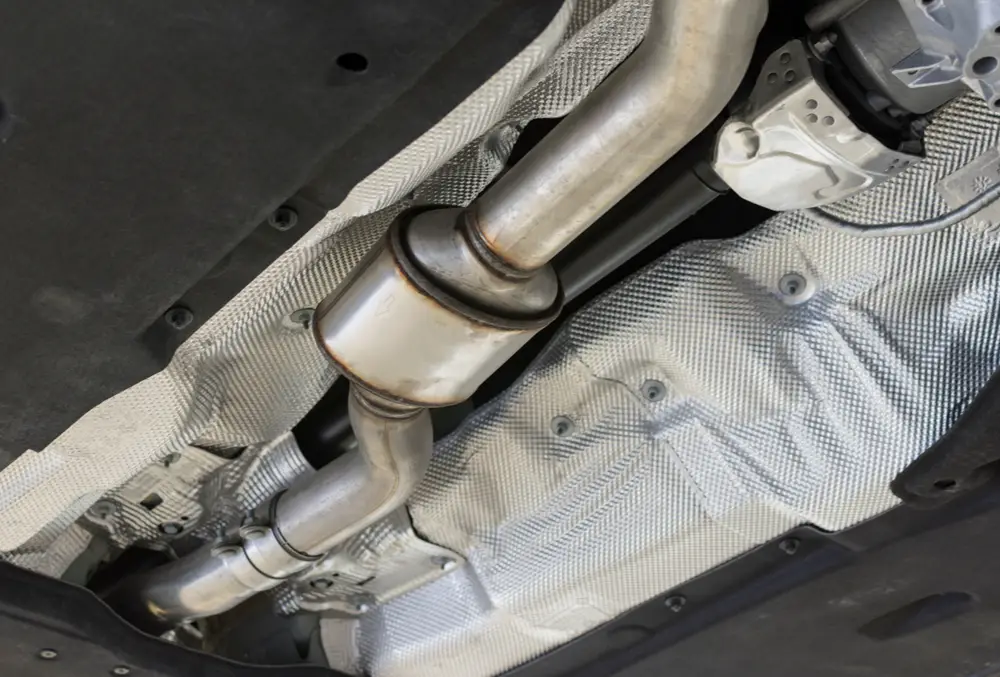Last Updated on May 11, 2022 by Fair Punishment Team
Following the laws of the road is incredibly important. It keeps you, your passengers, pedestrians and other road users safe.
What people often overlook is the impact vehicles have on the environment. Emissions from cars can be harmful to the environment, so it is a good question to ask about the legal nature of converters.
That, and there are many laws that try to protect the environment too. So, let’s examine the legal implications of driving without a catalytic converter, along with other handy information.

What Exactly Is A Catalytic Converter?
First introduced in the 1970s, catalytic converters are devices that aim to reduce the emissions from your car to the environment. Using catalysts, it changes (converts) the dangerous and harmful chemicals from the car into gasses that are harmless.
The harmful emissions prior to conversion include things like carbon monoxide, nitrogen oxide and hydrocarbon. The reduction of these gasses is crucial to the air quality and production of greenhouse gasses.
Due to the importance of reducing these harmful gasses, most federal and state laws demand their usage. Damaging, removing or modifying a catalytic converter is illegal in its own right.
Catalytic converters are made of metals – sometimes a mix of metals. They can include platinum, rhodium and palladium, but due to its superior oxidation – gold is often being included now. Not to mention, gold is cheaper than these other metals.
Oxidation refers to the burning process that the catalyst goes through. As it goes to such a high temperature with the metal properties, the composition is chemically altered and made safe.
For example, carbon monoxide is a dangerous emission which is converted into dioxide whereas nitrogen oxide is converted into nitrogen and oxygen.
As these are two naturally occurring elements in our atmosphere, it is not harmful to the environment. Any remaining hydrocarbons are altered into carbon dioxide and water.
How Do You Know If Your Catalytic Converter Is Working?
It would be useful to know if your catalytic converter is working properly or not – particularly if you’re buying a new car and don’t know of the signs of a broken, modified or missing catalytic converter.
Be sure to look out for the following symptoms:
Engine Performance Reduction
One of the most obvious indications that your catalytic converter is not functioning correctly is that you’ll notice the engine is not operating as it should.
As the converter is built into the exhaust system of the car, the engine’s performance will be reduced. If the converter system is clogged up, the flow of gasses will become restricted.
More to this, if your converter is broken through a crack, it will start leaking. Either of these problems will cause a power reduction and loss of acceleration power – which give poor fuel economy.
Sound Of Rattling
A failing catalytic converter can make rattling sounds. These sounds are caused by the mesh on the inside becoming deteriorated and breaking apart within due to a history of rich fuel mixture. Over time, this rattle might become more noticeable or irritating, the more it breaks apart.
Illuminated Check Engine Light
A lot of people wait for their car’s dashboard to let them know there’s a problem. Internal sensors of the vehicle will measure the levels of air and fuel and assess their ratio.
If there is a problem with gasses, or the sensors notice that they are not being converted in the right way – the check engine light can illuminate. This isn’t the most obvious way to know though, as the light can indicate a number of different problems.
The Car Is Failing Emissions Tests
Periodically, you’ll send your car in for checks. If your converter is not functioning correctly or is not present in the car at all, you’ll definitely fail this test. You may also notice the emissions from the car without a test due to their smell or vapor.
The Engine Misfires
The engine misfiring can be a sign of an overheated catalytic converter. You may also notice a reduction in power, or a total loss of power, when you’re hitting the gas pedal.

Can You Drive Without A Catalytic Converter?
You can still drive your vehicle without a catalytic converter – in that, the car will still move. The performance and legality on the other hand will not allow you to.
Driving with a converter will certainly provide you with a better car performance and you’ll enjoy the drive more. Additionally, you can keep the car (legally) over the years and pass emissions tests.
What Is The Law Surrounding Catalytic Converters?
The law differs from state to state. However, if your vehicle was fitted with a catalytic converter from the manufacturer, it is mandated by the state that you keep it through the Clean Air Act 1970.
That being said, cars manufactured before the introduction of catalytic converters in the 1970s do not have them fitted, and some experts believe this helps them operate better anyway.
Some states will allow you a pass with catalytic converts in this respect.Take Georgia for example. Georgia does not require emissions tests if the vehicle is older than 25 years.
Another thing to note is your validity of your car insurance. Some states will call your insurance invalid if you do not have a catalytic converter because the car is not road-legal.
When cars are imported to the US, they undergo a compliance test and will pass if they receive a ‘type approval’. They generally can only get this with a catalytic converter.
Summary
While you technically can drive without a catalytic converter, it is illegal to do so unless in very rare circumstances. Federal and state law will dictate that you have one that is untampered with and passes rigorous checks every now and then.
